The global water-soluble packaging market is valued at USD 4.7 billion in 2025 and is slated to reach USD 9.1 billion by 2035, recording an absolute increase of USD 4.4 billion over the forecast period.
Future Market Insights (FMI), a globally recognized leader in packaging market forecasts and material innovation studies, projects that this translates into a total growth of 93.6%, with the market forecast to expand at a compound annual growth rate (CAGR) of 6.8% between 2025 and 2035. The overall market size is expected to grow by nearly 1.94X during the same period, supported by increasing demand for single-dose packaging solutions in laundry and dishwasher applications, growing adoption of dissolvable film technologies in agrochemical delivery, and rising preference for convenient unit-dose formats across pharmaceutical packaging and industrial chemical distribution applications.
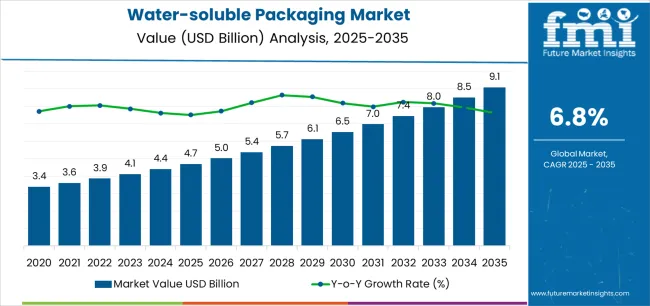
Between 2025 and 2030, the water-soluble packaging market is projected to expand from USD 4.7 billion to USD 6.6 billion, resulting in a value increase of USD 1.9 billion, which represents 43.2% of the total forecast growth for the decade. This phase of development will be shaped by increasing consumer demand for pre-measured laundry pods requiring water-dissolvable films, rising adoption of polyvinyl alcohol (PVA) based packaging structures, and growing demand for controlled-release agricultural chemical delivery systems with enhanced dissolution characteristics. Consumer goods manufacturers are expanding their water-soluble film sourcing capabilities to address the growing demand for single-dose detergent pods, dishwasher tablets, and specialty chemical unit-dose packaging requirements.
| Metric | Value |
|---|---|
| Estimated Value in (2025E) | USD 4.7 billion |
| Forecast Value in (2035F) | USD 9.1 billion |
| Forecast CAGR (2025 to 2035) | 6.8% |
From 2030 to 2035, the market is forecast to grow from USD 6.6 billion to USD 9.1 billion, adding another USD 2.5 billion, which constitutes 56.8% of the overall ten-year expansion. This period is expected to be characterized by the expansion of cold-water soluble film technologies, the integration of multi-chamber pod designs, and the development of temperature-controlled dissolution systems with optimized release performance. The growing adoption of automated pod manufacturing equipment will drive demand for water-soluble films with superior sealing properties and compatibility with high-speed filling operations across consumer goods production facilities.
Between 2020 and 2025, the water-soluble packaging market experienced robust growth, driven by increasing demand for convenient unit-dose packaging formats and growing recognition of water-soluble films as essential delivery systems for liquid detergents, powdered chemicals, and agrochemical formulations across household products, industrial cleaning, and agricultural applications. The market developed as manufacturers recognized the potential for water-soluble packaging to eliminate measuring errors, prevent product waste, and enable precise dosing while maintaining barrier protection and enabling mess-free handling formats. Technological advancement in PVA film extrusion processes and dissolution rate control began emphasizing the critical importance of maintaining film integrity during storage and achieving rapid dissolution performance in varied water conditions.
Market expansion is being supported by the increasing global demand for convenient consumer product formats and the corresponding need for packaging materials that can provide pre-measured dosing accuracy and complete dissolution while enabling simplified handling and eliminating packaging waste across various household, industrial, and agricultural applications. Modern consumer goods manufacturers and chemical formulators are increasingly focused on implementing packaging solutions that can deliver precise product quantities, prevent user exposure to concentrated chemicals, and provide consistent performance throughout diverse application environments. Water-soluble packaging's proven ability to deliver exceptional dosing convenience, enable contact-free product handling, and support waste elimination make them essential packaging formats for contemporary laundry products and cleaning chemical operations.
The growing emphasis on user convenience and product safety is driving demand for water-soluble films that can support unit-dose product innovation, improve application accuracy, and enable child-resistant packaging formats. Manufacturers' preference for packaging that combines dissolution reliability with processing versatility and barrier performance is creating opportunities for innovative water-soluble film implementations. The rising influence of premium laundry pods and concentrated cleaning formulations is also contributing to increased demand for water-soluble packaging that can provide moisture barrier protection, mechanical strength, and reliable dissolution across varied temperature conditions.
The water-soluble packaging market is poised for rapid growth and transformation. As industries across household cleaning, agrochemicals, pharmaceuticals, food service, and industrial chemicals seek packaging that delivers exceptional convenience, dosing precision, and waste reduction, water-soluble films are gaining prominence not just as specialty packaging but as strategic enablers of product innovation and user safety.
Rising unit-dose product adoption in North America and expanding laundry pod markets globally amplify demand, while manufacturers are leveraging innovations in cold-water dissolution films, multi-compartment pod structures, and controlled-release formulations.
Pathways like pharmaceutical unit-dose applications, agricultural chemical delivery systems, and industrial cleaning pods promise strong margin uplift, especially in high-value segments. Geographic expansion and vertical integration will capture volume, particularly where local manufacturing capabilities and specialized film production are critical. Regulatory pressures around chemical handling safety, child-resistant packaging requirements, and precise dosing standards give structural support.
The market is segmented by material type, application, dissolution temperature, film thickness, end-use industry, and region. By material type, the market is divided into polyvinyl alcohol (PVA), polyvinyl acetate derivatives, and others. By application, it covers detergents & cleaning products, agrochemicals, pharmaceuticals & healthcare, food & beverages, industrial chemicals, and others. By dissolution temperature, the market is segmented into cold water soluble (below 20°C), warm water soluble (20-40°C), and hot water soluble (above 40°C). The film thickness includes standard (25-50 microns), medium (50-75 microns), and heavy-duty (above 75 microns). By end-use industry, it is categorized into household care, agriculture, healthcare & pharmaceuticals, food service, and industrial & institutional. Regionally, the market is divided into North America, Europe, East Asia, South Asia & Pacific, Latin America, and the Middle East & Africa.
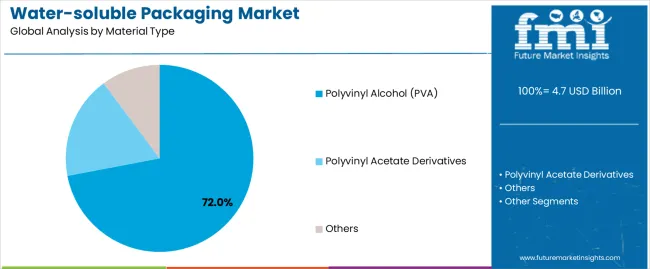
The polyvinyl alcohol segment is projected to account for 72% of the water-soluble packaging market in 2025, reaffirming its position as the leading material category. Consumer goods manufacturers and chemical formulators increasingly utilize PVA-based water-soluble films for their superior water dissolution properties when processed through specialized extrusion technologies, excellent barrier characteristics against moisture and oxygen, and compatibility in applications ranging from laundry detergent pods to agrochemical packaging. PVA film technology's advanced sealing capabilities and consistent dissolution performance directly address the industrial requirements for reliable product delivery in single-dose packaging environments.
This material segment forms the foundation of modern unit-dose packaging operations, as it represents the water-soluble film type with the greatest processing versatility and established market acceptance across multiple application categories and industry sectors. Manufacturer investments in enhanced dissolution rate control technologies and automated pod-filling compatibility continue to strengthen adoption among consumer brands and industrial chemical producers. With companies prioritizing dosing accuracy and handling convenience, PVA-based water-soluble films align with both performance requirements and manufacturing efficiency objectives, making them the central component of comprehensive unit-dose packaging strategies.
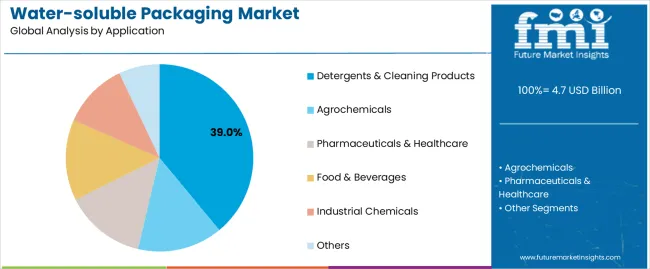
Detergents & cleaning products applications are projected to represent 39% of water-soluble packaging demand in 2025, underscoring their critical role as the primary industrial consumers of water-dissolvable films for laundry pods, dishwasher tablets, and concentrated cleaning chemical delivery. Consumer goods manufacturers prefer water-soluble packaging for their exceptional pre-measured dosing capabilities, mess-free handling characteristics, and ability to prevent product waste while ensuring consistent cleaning performance with precise chemical delivery. Positioned as essential packaging formats for modern household care products, water-soluble films offer both convenience advantages and safety benefits.
The segment is supported by continuous innovation in multi-chamber pod technologies and the growing availability of specialized film formulations that enable liquid-powder separation with enhanced dissolution reliability and child-resistant closure compatibility. Additionally, cleaning product manufacturers are investing in high-speed pod manufacturing systems to support large-volume production requirements and packaging efficiency. As premium laundry pod demand becomes more prevalent and concentrated detergent formats increase, detergents & cleaning products applications will continue to dominate the end-use market while supporting advanced unit-dose packaging utilization and product innovation strategies.
The water-soluble packaging market is advancing rapidly due to increasing demand for convenient unit-dose packaging formats and growing adoption of dissolvable film solutions that provide superior dosing accuracy and handling safety while enabling waste elimination across diverse household care, agricultural, and pharmaceutical applications. However, the market faces challenges, including moisture sensitivity during storage, higher material costs compared to conventional films, and the need for specialized manufacturing equipment investments. Innovation in cold-water soluble formulations and multi-layer film structures continues to influence product development and market expansion patterns.
The growing adoption of cold-water soluble formulations, low-temperature compatible PVA films, and energy-efficient dissolution systems is enabling manufacturers to produce water-soluble packaging with superior performance at reduced washing temperatures, enhanced consumer appeal properties, and compatibility with energy-saving appliance functionalities. Advanced cold-water systems provide improved environmental benefits while allowing more efficient resource utilization and consistent performance across various temperature conditions and water hardness levels. Manufacturers are increasingly recognizing the competitive advantages of cold-water dissolution capabilities for product differentiation and premium market positioning.
Modern water-soluble packaging producers are incorporating multi-compartment pod designs, separated liquid-powder chamber configurations, and sequential release mechanisms to enhance product performance, enable complex formulation delivery, and deliver value-added solutions to consumer goods and chemical customers. These technologies improve cleaning efficacy while enabling new product capabilities, including targeted ingredient release, optimized chemical reactions, and enhanced visual appeal. Advanced multi-chamber integration also allows manufacturers to support premium product development and format innovation beyond traditional single-compartment pod approaches.
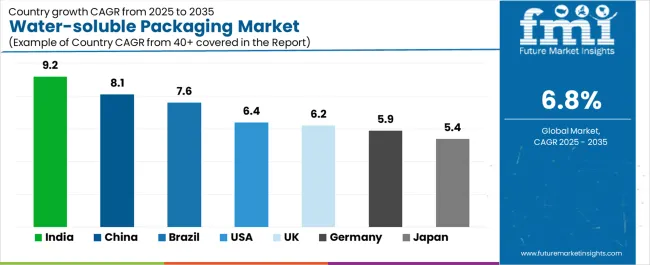
| Country | CAGR (2025-2035) |
|---|---|
| USA | 6.4% |
| China | 8.1% |
| Germany | 5.9% |
| India | 9.2% |
| Japan | 5.4% |
| United Kingdom | 6.2% |
| Brazil | 7.6% |
The water-soluble packaging market is experiencing strong growth globally, with India leading at a 9.2% CAGR through 2035, driven by the expanding household care products sector, growing adoption of laundry pods, and significant investment in consumer goods manufacturing infrastructure. China follows at 8.1%, supported by rapid detergent pod market growth, increasing agricultural chemical applications, and growing domestic production capabilities. Brazil records 7.6%, focusing on premium cleaning product adoption and consumer convenience trends. The USA shows growth at 6.4%, emphasizing product innovation and unit-dose format development. United Kingdom demonstrates 6.2% growth, prioritizing convenience packaging and concentrated cleaning solutions. Germany exhibits 5.9% growth, emphasizing precision manufacturing and quality film production. Japan shows 5.4% growth, supported by advanced packaging technologies and specialty product development.
The report covers an in-depth analysis of 40+ countries top-performing countries are highlighted below.
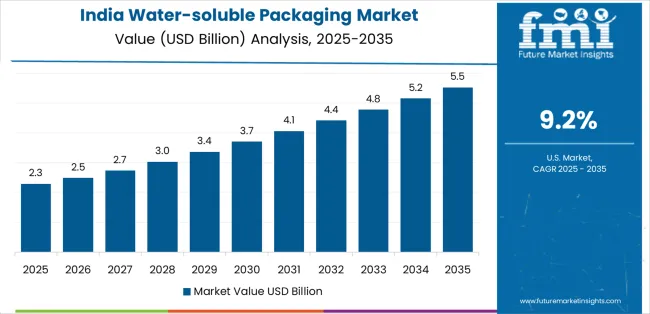
Revenue from water-soluble packaging in India is projected to exhibit exceptional growth with a CAGR of 9.2% through 2035, driven by expanding middle-class consumption patterns and rapidly growing detergent pod adoption supported by urbanization trends and modern retail development. The country's strong position in consumer goods manufacturing and increasing investment in household care production facilities are creating substantial demand for water-soluble film solutions. Major consumer brands and detergent manufacturers are establishing comprehensive water-soluble packaging sourcing capabilities to serve both domestic market demand and premium product segments.
Revenue from water-soluble packaging in China is expanding at a CAGR of 8.1%, supported by the country's massive household care market, expanding agricultural chemical sector, and increasing adoption of unit-dose packaging formats. The country's government initiatives promoting advanced manufacturing and growing consumer preference for premium products are driving requirements for sophisticated water-soluble film capabilities. International suppliers and domestic manufacturers are establishing extensive production facilities to address the growing demand for detergent pods and agricultural chemical delivery systems.
Revenue from water-soluble packaging in the USA is expanding at a CAGR of 6.4%, supported by the country's mature laundry pod market, strong emphasis on product innovation, and robust demand for specialized water-soluble films in pharmaceutical and industrial applications. The nation's established consumer goods sector and safety-focused regulations are driving sophisticated multi-chamber pod systems throughout the supply chain. Leading manufacturers and technology providers are investing extensively in cold-water dissolution technologies and biodegradable film formulations to serve both domestic and international markets.
Revenue from water-soluble packaging in Brazil is growing at a CAGR of 7.6%, driven by the country's expanding middle class, growing adoption of concentrated cleaning products, and increasing investment in modern consumer goods manufacturing. Brazil's large population base and commitment to retail modernization are supporting demand for water-soluble packaging solutions across household care segments. Manufacturers are establishing production capabilities to serve the growing domestic market and regional distribution opportunities.
Revenue from water-soluble packaging in Germany is expanding at a CAGR of 5.9%, supported by the country's chemical industry leadership, advanced film production capabilities, and strategic focus on high-performance water-soluble materials. Germany's engineering expertise and quality standards are driving demand for water-soluble films in industrial cleaning, pharmaceutical packaging, and export-oriented consumer goods applications. Manufacturers are investing in comprehensive quality control systems to serve both domestic brands and international specialty markets.
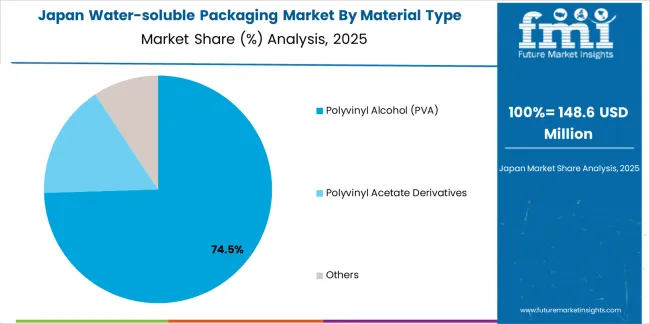
Revenue from water-soluble packaging in Japan is growing at a CAGR of 5.4%, driven by the country's expertise in polymer technology, emphasis on product innovation, and strong position in specialty chemical and pharmaceutical packaging. Japan's established materials science capabilities and commitment to quality improvement are supporting investment in advanced water-soluble film technologies throughout major manufacturing centers. Industry leaders are establishing comprehensive research programs to serve domestic consumer brands and specialized industrial applications.
Revenue from water-soluble packaging in the United Kingdom is expanding at a CAGR of 6.2%, supported by the country's mature detergent pod market, growing demand for eco-conscious packaging solutions, and strategic position in European consumer goods distribution. The UK's established retail sector and consumer preference for convenience products are driving demand for advanced water-soluble packaging in laundry applications, dishwasher tablets, and specialty cleaning formats. Leading brands are investing in innovative pod designs to serve the competitive requirements of retail chains and online marketplaces.

The water-soluble packaging market in Europe is projected to grow from USD 1.3 billion in 2025 to USD 2.5 billion by 2035, registering a CAGR of 6.7% over the forecast period. Germany is expected to maintain its leadership position with a 33.0% market share in 2025, declining slightly to 32.5% by 2035, supported by its strong chemical manufacturing industry, advanced polymer processing capabilities, and comprehensive household care product sector serving diverse water-soluble film applications across Europe.
The United Kingdom follows with a 21.0% share in 2025, projected to reach 21.5% by 2035, driven by robust demand for water-soluble packaging in laundry pod applications, dishwasher tablet production, and premium cleaning product formats, combined with established consumer brands and retail distribution networks. France holds a 17.0% share in 2025, expected to reach 17.5% by 2035, supported by strong household care market and growing pharmaceutical applications. Italy commands a 12.0% share in 2025, projected to reach 12.3% by 2035, while Spain accounts for 7.5% in 2025, expected to reach 8.0% by 2035. The Netherlands maintains a 4.0% share in 2025, growing to 4.2% by 2035. The Rest of Europe region, including Nordic countries, Eastern Europe, Belgium, Poland, and other nations, is anticipated to maintain momentum, with its collective share moving from 5.5% to 4.0% by 2035, attributed to increasing consumer goods manufacturing in Eastern Europe and growing detergent pod adoption in Nordic countries implementing advanced unit-dose packaging programs.

The water-soluble packaging market is characterized by competition among established polymer film manufacturers, specialized water-soluble material producers, and integrated packaging solutions providers. Companies are investing in PVA film technology research, dissolution rate optimization, multi-chamber pod development, and comprehensive product portfolios to deliver consistent, high-performance, and application-specific water-soluble packaging solutions. Innovation in cold-water dissolution materials, barrier enhancement technologies, and automated manufacturing compatibility is central to strengthening market position and competitive advantage.
MonoSol LLC leads the market with a strong market share, offering comprehensive water-soluble film solutions with a focus on consumer goods and industrial applications. Kuraray Co. Ltd. provides specialized PVA film capabilities with an emphasis on high-barrier formulations and pharmaceutical-grade materials. Sekisui Chemical Co. Ltd. delivers innovative polymer technologies with a focus on advanced dissolution control and multi-layer structures. Aicello Corporation specializes in water-soluble film production and customized packaging solutions for diverse end-use applications. Cortec Corporation focuses on corrosion protection applications and industrial chemical packaging formats. JRF Technology LLC offers specialized agricultural chemical delivery systems with emphasis on field application compatibility.
| Items | Values |
|---|---|
| Quantitative Units (2025) | USD 4.7 billion |
| Material Type | Polyvinyl Alcohol (PVA), Polyvinyl Acetate Derivatives, Others |
| Application | Detergents & Cleaning Products, Agrochemicals, Pharmaceuticals & Healthcare, Food & Beverages, Industrial Chemicals, Others |
| Dissolution Temperature | Cold Water Soluble (Below 20°C), Warm Water Soluble (20-40°C), Hot Water Soluble (Above 40°C) |
| Film Thickness | Standard (25-50 microns), Medium (50-75 microns), Heavy-Duty (Above 75 microns) |
| End-Use Industry | Household Care, Agriculture, Healthcare & Pharmaceuticals, Food Service, Industrial & Institutional |
| Regions Covered | North America, Europe, East Asia, South Asia & Pacific, Latin America, Middle East & Africa |
| Countries Covered | United States, Canada, United Kingdom, Germany, France, China, Japan, South Korea, India, Brazil, Australia and 40+ countries |
| Key Companies Profiled | MonoSol LLC, Kuraray Co. Ltd., Sekisui Chemical Co. Ltd., Aicello Corporation, Cortec Corporation, and JRF Technology LLC |
| Additional Attributes | Dollar sales by material type and application category, regional demand trends, competitive landscape, technological advancements in dissolution control systems, multi-chamber pod development, cold-water film innovation, and supply chain integration |
The global water-soluble packaging market is estimated to be valued at USD 4.7 billion in 2025.
The market size for the water-soluble packaging market is projected to reach USD 9.1 billion by 2035.
The water-soluble packaging market is expected to grow at a 6.8% CAGR between 2025 and 2035.
The key product types in water-soluble packaging market are polyvinyl alcohol (pva), polyvinyl acetate derivatives and others.
In terms of application, detergents & cleaning products segment to command 39.0% share in the water-soluble packaging market in 2025.






Full Research Suite comprises of:
Market outlook & trends analysis
Interviews & case studies
Strategic recommendations
Vendor profiles & capabilities analysis
5-year forecasts
8 regions and 60+ country-level data splits
Market segment data splits
12 months of continuous data updates
DELIVERED AS:
PDF EXCEL ONLINE
Competitive Breakdown of Water-Soluble Packaging Companies
Packaging Testing Services Market Size and Share Forecast Outlook 2025 to 2035
Packaging Tubes Market Size and Share Forecast Outlook 2025 to 2035
Packaging Jar Market Forecast and Outlook 2025 to 2035
Packaging Barrier Film Market Size and Share Forecast Outlook 2025 to 2035
Packaging Films Market Size and Share Forecast Outlook 2025 to 2035
Packaging Laminate Market Size and Share Forecast Outlook 2025 to 2035
Packaging Burst Strength Test Market Size and Share Forecast Outlook 2025 to 2035
Packaging Tapes Market Analysis - Size, Share, & Forecast Outlook 2025 to 2035
Packaging Materials Market Size and Share Forecast Outlook 2025 to 2035
Packaging Labels Market Size and Share Forecast Outlook 2025 to 2035
Packaging Equipment Market Size and Share Forecast Outlook 2025 to 2035
Packaging Resins Market Size and Share Forecast Outlook 2025 to 2035
Packaging Inspection Systems Market Size and Share Forecast Outlook 2025 to 2035
Packaging Design And Simulation Technology Market Size and Share Forecast Outlook 2025 to 2035
Packaging Suction Cups Market Size and Share Forecast Outlook 2025 to 2035
Packaging Straps and Buckles Market Size and Share Forecast Outlook 2025 to 2035
Packaging Coating Market Analysis - Size, Share, & Forecast Outlook 2025 to 2035
Packaging Testing Equipment Market Analysis & Growth 2025 to 2035
Packaging Bins Market Trends - Growth & Demand 2025 to 2035

Thank you!
You will receive an email from our Business Development Manager. Please be sure to check your SPAM/JUNK folder too.
Chat With
MaRIA